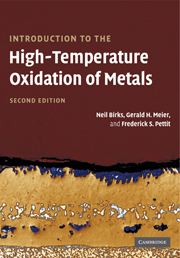Book contents
- Frontmatter
- Contents
- Acknowledgements
- Preface
- Introduction
- 1 Methods of investigation
- 2 Thermodynamic fundamentals
- 3 Mechanisms of oxidation
- 4 Oxidation of pure metals
- 5 Oxidation of alloys
- 6 Oxidation in oxidants other than oxygen
- 7 Reactions of metals in mixed environments
- 8 Hot corrosion
- 9 Erosion–corrosion of metals in oxidizing atmospheres
- 10 Protective coatings
- 11 Atmosphere control for the protection of metals during production processes
- Appendix A Solution to Fick's second law for a semi-infinite solid
- Appendix B Rigorous derivation of the kinetics of internal oxidation
- Appendix C Effects of impurities on oxide defect structures
- Index
- References
9 - Erosion–corrosion of metals in oxidizing atmospheres
Published online by Cambridge University Press: 05 June 2012
- Frontmatter
- Contents
- Acknowledgements
- Preface
- Introduction
- 1 Methods of investigation
- 2 Thermodynamic fundamentals
- 3 Mechanisms of oxidation
- 4 Oxidation of pure metals
- 5 Oxidation of alloys
- 6 Oxidation in oxidants other than oxygen
- 7 Reactions of metals in mixed environments
- 8 Hot corrosion
- 9 Erosion–corrosion of metals in oxidizing atmospheres
- 10 Protective coatings
- 11 Atmosphere control for the protection of metals during production processes
- Appendix A Solution to Fick's second law for a semi-infinite solid
- Appendix B Rigorous derivation of the kinetics of internal oxidation
- Appendix C Effects of impurities on oxide defect structures
- Index
- References
Summary
Introduction
Under many service situations, materials are exposed to high-temperature gas streams. A gas stream can entrain solid particles, picking up larger particles at higher speeds. In fact it is probable that a particle-free gas flow can only be provided under the most carefully contrived laboratory conditions. In most practical cases, gas streams will contain solid particles. Good examples of this are found in gas turbines, oil refining and reforming, as well as in power generation. This chapter will address the ways in which the oxidation and solid-particle erosion of metals proceed simultaneously and interact.
Erosion of materials
To understand how erosion and oxidation interact, it is necessary to understand how metals and oxides erode. Previous work into the erosion of metals and ceramics at room temperature has shown that the erosion of ductile material involves plastic deformation, cutting, plowing, and fatigue. These mechanisms can occur by the impact of a single particle, as in the case of cutting, or may require several subsequent impacts as in the cases of plowing and fatigue. Brittle materials, on the other hand, erode by the introduction of intersecting brittle crack systems. Most of the metals in use respond in a basically ductile manner at high temperatures. The oxides that arise from oxidation can be either quite ductile (wustite, nickel oxide, etc.) or quite brittle (alumina, chromia, etc.). Depending on the oxide and the circumstances, the oxide scale can be deformed plastically by the erosive impacts; alternatively the oxide could spall under impact.
- Type
- Chapter
- Information
- Introduction to the High Temperature Oxidation of Metals , pp. 253 - 270Publisher: Cambridge University PressPrint publication year: 2006



